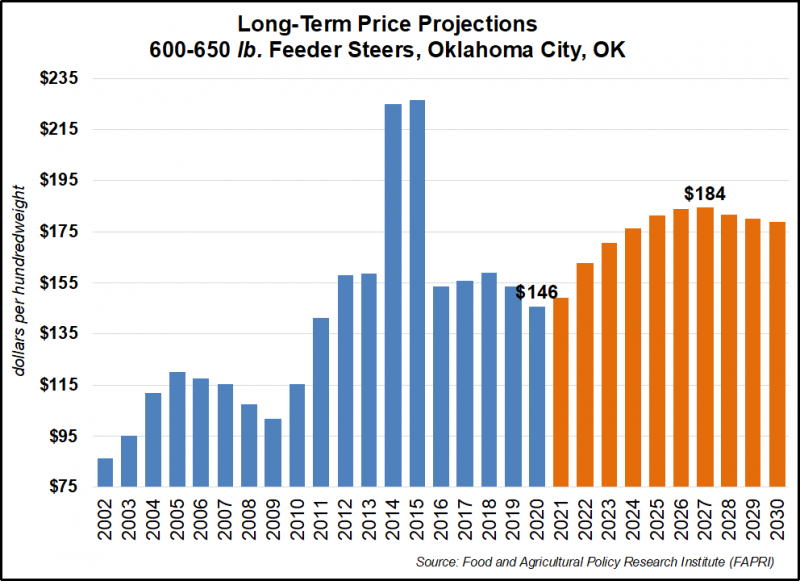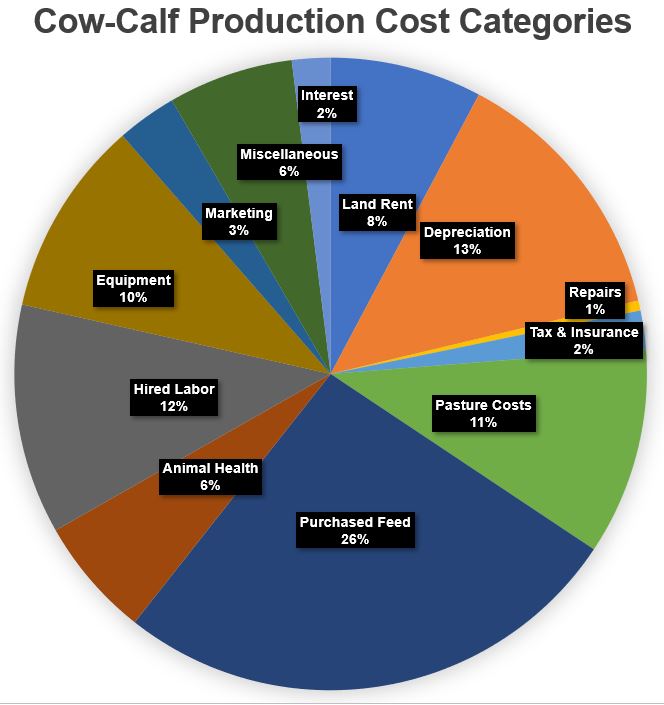Doug Mayo, UF/IFAS Jackson County Extension Director & Chris Prevatt, UF/IFAS Livestock & Forage Economist
2020 was a challenging year in all sorts of ways. For cattle producers, there were market disruptions, meat processor shutdowns, significant market price drops, restaurant and hotel shutdowns, unemployment spikes, and a lot of uncertainty for the US economy. 2021 offers hope for the future. Cattle prices have slowly responded to the improving economy and the reopening of business that purchase high quality beef. There are also fewer cattle than two years ago, when the national cattle inventory peaked. If the current drought in the western states continues, the cattle herd inventory could be further reduced. With improved demand and reduced supply, there is hope for better market prices ahead.
The Food Agriculture Policy Research Institute provides price projections for different commodities. The following chart compares the value of feeder cattle through the years to an estimated value of feeder steers in the coming years. Based on their current estimates, cattle prices are anticipated to peak in 2027. At this time, they are expecting only a modest $3/cwt increase in 2021, but forecast steady improvement for the next five years.
–
Costs Rising Faster than Cattle Prices
The problem is supply shortages and inflation have rapidly increased the prices for key agricultural inputs over the past six months. As fuel, steel, fertilizer, grain, lumber, and other resources climb, input costs for farms and ranchers have increased significantly. Likely, input costs will continue to increase faster than cattle prices. This dilemma is not new, but could be especially challenging over the next few years.
The question you need to constantly ask yourself is, “How can I keep input costs low enough to remain profitable?” If the primary product you sell are weaned calves, there are tools you can use to minimize price discounts, but you sell in a commodity market with limited control of the income you can generate. This forces you to focus much of your management energy on limiting or controlling costs wherever possible.
–
Evaluating 2020 Costs
What is the best place to start evaluating my costs? The Schedule F Form you completed for filing your farm income taxes is a great resource to use to compare what you earned and what you spent in 2020. Since you have already gathered up all this information, you have an opportunity to break down costs and income into categories. If you start tracking unit-based costs (cost/cow, costs/bale, costs/acre), it is easier to make management decisions in the future. A simple spreadsheet can be helpful as it makes the math easy, and allows you to break the categories down on a per unit basis, and provide data as shown in Figure 1. These categories and percentage may not match your operation, but you can see how they compare.
–
Once you know your expenses by category and costs per cow, you can focus on reducing the largest expenses that will have the greatest impact. For instance, the cost of feeding your herd (hay, feed, mineral) is likely more than 25% of your annual cow costs. Conversely the total costs for drugs, vaccines, and other veterinary expenses are about 6%. While the bills for drugs and medications are significant, you can’t make as much impact with cost reductions in that catergory. You also must evaluate the risks of cutting expenses, as sick, or dead cattle will reduce revenue much more significantly than the cost of the vaccines that prevent these losses.
–
Building an Operation Budget
Once you know how much you have spent by category from the previous year, you can create an operation budget to work from for the current year. If you would like to see example budgets to get ideas for how to organize your records, you may want to look at the UF Cow-Calf Budget or the UGA Cow-Calf Budget to get ideas on how to organize your own budget. Once you have a solid budget based on 2020 expenses, you can start to consider strategies manage costs in 2021. Now that you know what you spent in the past, you analyze other options that might be available for future purchases.
Once you start homing in on ways to reduce costs, you must evaluate each decision, as cutting costs can have some impact on performance. For instance, fertilizer is one of the largest pasture management expenses. But, if you eliminate or reduce fertilizer inputs, you will also reduce the yield of pastures and be forced to purchase more hay and feed supplements when the grass runs out in the fall. Another option would be to reduce fertilizer inputs, while also reducing the stocking rate to compensate. However, if you have fewer cattle then your income will also be reduced. There is a tradeoff that must be accounted for with each option evaluated.
–
Bulk Purchases
One of the most common options cattlemen seek are opportunities to purchase items in bulk. Instead of buying a few posts for each fence repair, you may be able purchase bundles of posts at a reduced cost. Can you handle and buy feed in bulk instead of by the bag or on an as needed basis through the winter? Anytime you can buy larger quantities in advance there are opportunities for reducing expenses, but this may require a purchasing strategy. If you have the records of what was purchased the previous year, you can compare options available and develop a plan to purchase them in advance at some level of discount. If you find opportunities to save money with bulk purchases, you are likely going to give up some convenience to gain this price advantage. There are also opportunities to work with other ranchers in the area to make this work to the full advantage. It might be that 5 other ranchers in your area could go together with you to purchase a truckload of fence posts direct from the manufacturer. Or perhaps, you could work with a large ranch to get in on their bulk orders of products. This type of cooperative purchasing has worked well in other states, where cattle producers identify items that are commonly purchased annually that can be ordered in advance with larger quantities direct from a wholesale outlet.
–
Reducing Waste
Another key area to evaluate is reducing waste. Hay is a large expense for ranchers and is also an area that can have significant levels of waste. If you store hay outside on the ground, you will have significant storage waste, as the exterior of the bale weathers and deteriorates. You can also have significant losses as you feed hay, especially if you feed on the ground or cattle pull the hay out from the feeder and tromp or lay on the hay. Investing in storage and feeding systems can be expensive, but if you do the math hay barns and good quality hay feeders will pay for themselves, if they can be used long enough to significantly minimize hay waste. Another area of waste I have seen is stored feed that spoils, so make sure if you by bulk feed you don’t lose the savings with storage losses. There can even be waste with annual forages. Grazing a few hours per day reduces waste as compared to 24-hour access. The point is to look at categories with large expense to see if you can reduce waste, so that the money invested is utilized as efficiently as possible.
–
Summary
Finding ways to reduce input costs is not an easy task. In general, cattle producers are already aware of the need to keep their costs as low as they can. If you use the data from your federal tax returns, you already have some excellent records to begin to evaluate how much you are spending and look for alternative options. You don’t have to work on this alone. Contact your local extension agent, veterinarian, farm supply dealers, and other producers to get their suggestions for options to reduce costs. I am sure it will take some trial and error to find good solutions, but with some effort you may be able to find enough savings to stay profitable even when input costs are rising faster than cattle prices.
- November 2025 Weather Summary & Winter Outlook - December 5, 2025
- Friday Feature: The History of Beekeeping - December 5, 2025
- Friday Feature:Malone Pecan Festival Tractorcade - November 21, 2025


